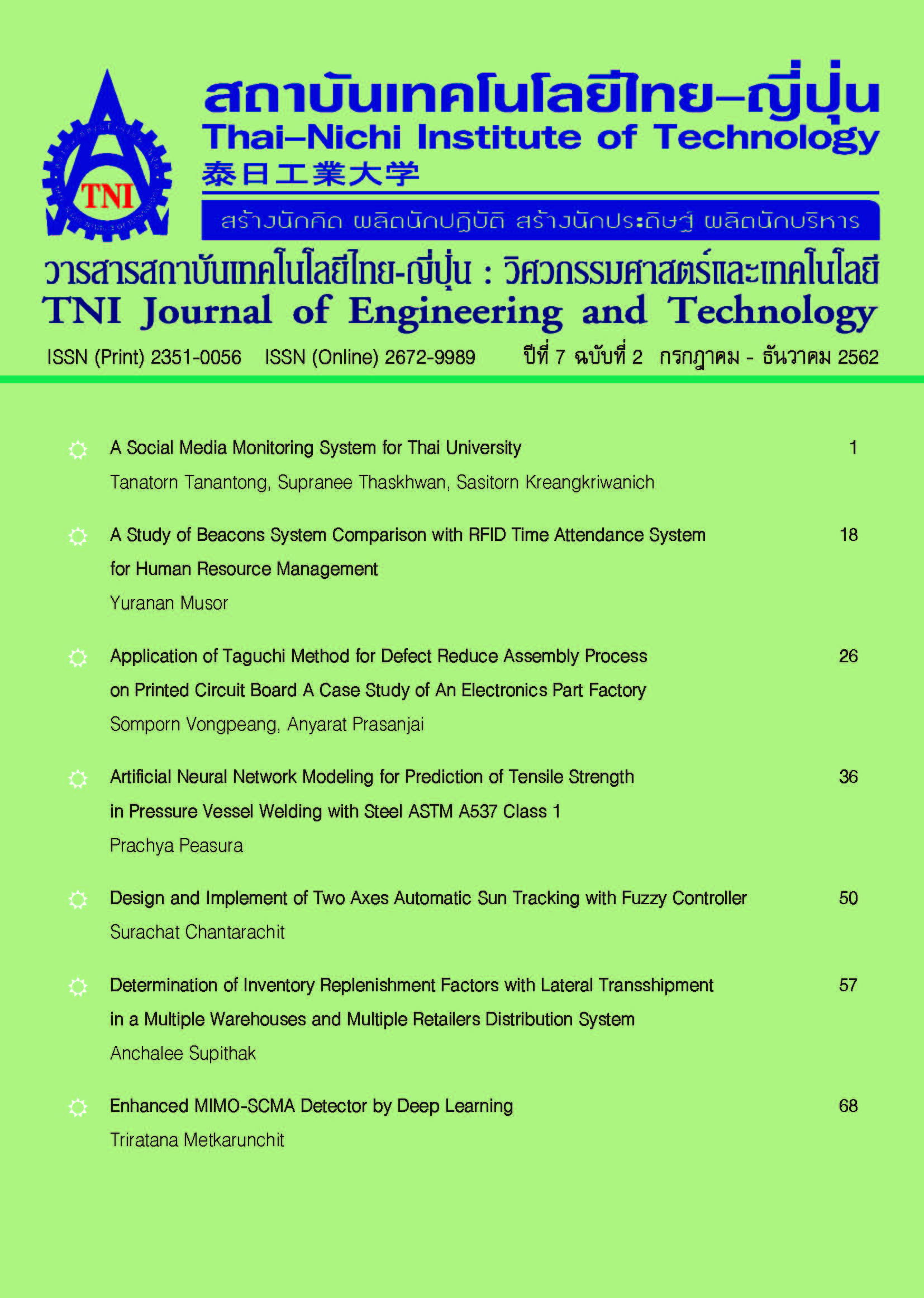Improving the Performance of Tree Algorithm using Mixed Splitting Algorithm
Main Article Content
Abstract
The aim of this research is to enhance the performance of tree algorithm using mixed splitting algorithm. Binary tree is very efficient when the number of users is small. In case of large number of users, Ternary tree performs better than other algorithms. Therefore, this paper introduces mixed splitting algorithm. The details of this algorithm are as follows. When the number of the collided users is small, this algorithm will split the collided users into 2 groups. In case of large number of users, this algorithm will split the collided users into 3 groups. From the results, we found that the probability of success of the proposed algorithm tends to be higher than the Binary and Ternary algorithms. With this reason, the proposed algorithm performs superior performance than other algorithms.
Article Details
Article Accepting Policy
The editorial board of Thai-Nichi Institute of Technology is pleased to receive articles from lecturers and experts in the fields of engineering and technology written in Thai or English. The academic work submitted for publication must not be published in any other publication before and must not be under consideration of other journal submissions. Therefore, those interested in participating in the dissemination of work and knowledge can submit their article to the editorial board for further submission to the screening committee to consider publishing in the journal. The articles that can be published include solely research articles. Interested persons can prepare their articles by reviewing recommendations for article authors.
Copyright infringement is solely the responsibility of the author(s) of the article. Articles that have been published must be screened and reviewed for quality from qualified experts approved by the editorial board.
The text that appears within each article published in this research journal is a personal opinion of each author, nothing related to Thai-Nichi Institute of Technology, and other faculty members in the institution in any way. Responsibilities and accuracy for the content of each article are owned by each author. If there is any mistake, each author will be responsible for his/her own article(s).
The editorial board reserves the right not to bring any content, views or comments of articles in the Journal of Thai-Nichi Institute of Technology to publish before receiving permission from the authorized author(s) in writing. The published work is the copyright of the Journal of Thai-Nichi Institute of Technology.
References
[2] J. Choi, “Throughput Analysis for Coded Multichannel ALOHA Random Access,” IEEE Communications Letters, Vol. 21, No. 8, pp. 1803-1806, Aug. 2017.
[3] H. J. Noh, J. K. Lee and J. S. Lim, “ANC-ALOHA: Analog Network Coding ALOHA for Satellite Networks,” IEEE Communications Letters, Vol. 18, No. 6, pp. 957 – 960, June 2014.
[4] J. Yu and L. Chen, “Stability Analysis of Frame Slotted Aloha Protocol,” Mobile Computing IEEE Transactions, Vol. 16, No. 5, pp. 1462-1474, 2017.
[5] H. Baek, J. Lim and S. Oh, “Beacon-Based Slotted ALOHA for Wireless Networks with Large Propagation Delay,” IEEE Communications Letters, Vol. 17, No. 11, pp. 2196 - 2199, Nov. 2013.
[6]M. Karaca and B. Landfeldt, “Approaching Optimal Centralized Scheduling With CSMA-Based Random Access Over Fading Channels,” IEEE Trans. Comm., Vol. 20, No. 6, pp. 1183 - 1186, June 2016.
[7] A. Maatouk, M. Assaad and A. Ephremides, “Energy Efficient and Throughput Optimal CSMA Scheme,” IEEE/ACM Transactions on Networking, Vol. 27, No. 1, pp. 316 - 329, Feb. 2019.
[8] Q. Liu, Y. Lu, G. Hu, S. Lv, X. Wang and X. Zhou., “Cooperative control feedback: On backoff misbehavior of CSMA/CA MAC in channel-hopping cognitive radio networks,” Journal of Communications and Networks, Vol. 20, No. 6, pp. 523 - 535, Dec. 2018.
[9] A. Maatouk, M. Assaad and A. Ephremides, “Performance Analysis of CSMA/CA based Medium Access in Full Duplex Wireless Communications,” IEEE Transactions on Mobile Computing, Vol. 15, No. 6, pp. 1457 - 1470, June 2016.
[10]S. H. Kim and P. Park, “An Efficient Tree-Based Tag Anti-Collision Protocol for RFID Systems,” IEEE Communications Letters, Vol. 11, No. 5, pp. 449 - 451, May 2007.
[11] J. I. Capetanakis, “Tree Algorithms for Packet Broadcast Channels,” IEEE Trans. Inform. Theory, Vol. IT-25, pp. 505–515, Sept. 1979.
[12] P. Mathys, P. Flajolet, “Q-ary collision resolution algorithms in random-access systems with free or blocked channel access,” IEEE Trans. Inform. Theory, Vol.31, pp-217-243,Mar. 1985.
[13]H. Wu and Y. Pan, Medium Access Control in Wireless Networks. New York: Nova Science, 2008.


